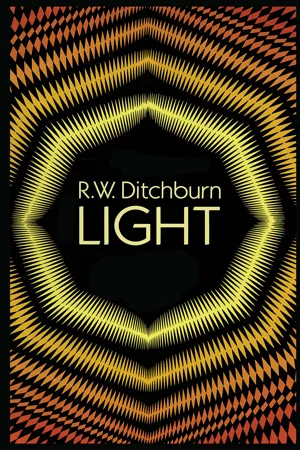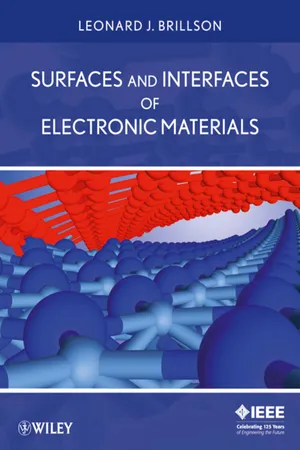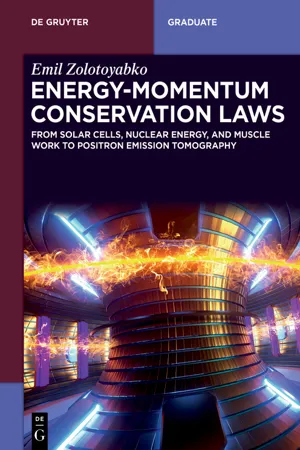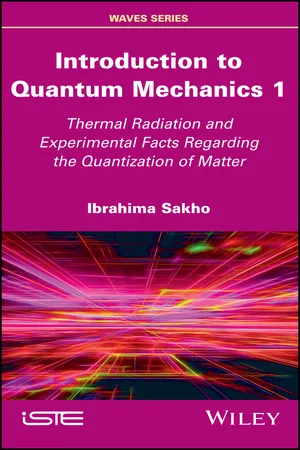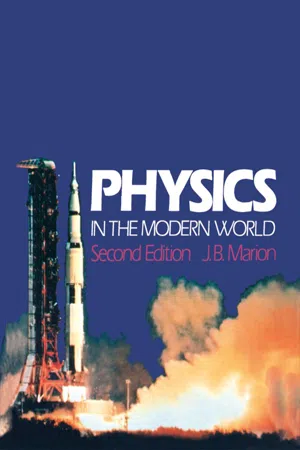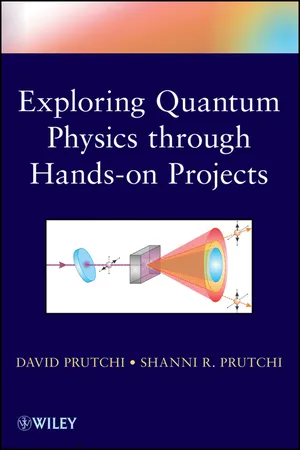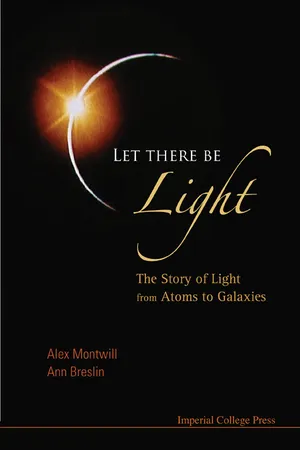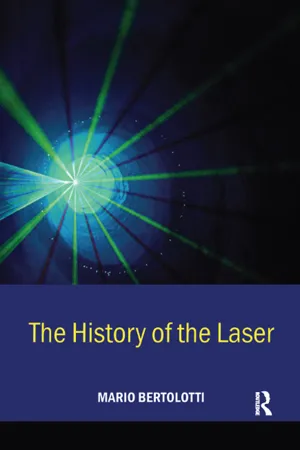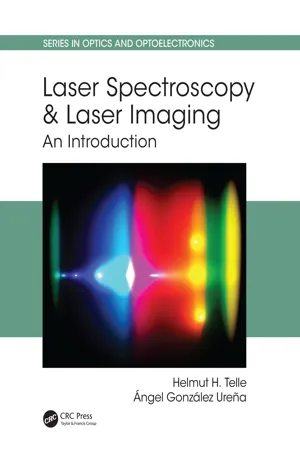Chemistry
Photoelectric Effect
The photoelectric effect refers to the emission of electrons from a material when it is exposed to light or other electromagnetic radiation. This phenomenon played a crucial role in the development of quantum mechanics and the understanding of the particle-like behavior of light. The effect is described by the equation E = hf - φ, where E is the kinetic energy of the emitted electrons, h is Planck's constant, f is the frequency of the incident light, and φ is the material's work function.
Written by Perlego with AI-assistance
Related key terms
Related key terms
1 of 4
Related key terms
1 of 3
11 Key excerpts on "Photoelectric Effect"
- eBook - ePub
- R. W. Ditchburn(Author)
- 2013(Publication Date)
- Dover Publications(Publisher)
Planck’s original theory was concerned only with the interaction of radiation and matter. He hoped that it would involve only minor modifications of the classical electromagnetic theory of light and the classical electron theory of matter. This expectation was not fulfilled and it became necessary to modify the theory of light to include the fact that energy of the radiation field which represents a beam of light can change only by an integral number of quanta. It is also necessary to assume that an atom can change its energy only by discrete amounts, and hence that atoms can exist only in certain states separated by finite differences of energy. Nothing in the classical laws of electromagnetism, which are based on experiments with static fields or alternating fields of low frequency, would lead us to expect this effect.The quantum theory thus becomes both a theory of radiation and a theory of matter instead of being merely a special hypothesis concerning their interaction. The theory is a connected whole and we cannot deal with a section of the theory concerning radiation without referring extensively to atomic structure. In this chapter we discuss the experimental basis of the quantum theory, giving special prominence to experiments on light and on electromagnetic radiation of shorter wavelength. The order is chosen for convenience of exposition and does not follow the historical order.17.2. The Photo-electric Effect.It is found that electrons are ejected from the surfaces of metals by light and by radiation of shorter wavelength (X-rays and y-rays). If the radiation is able to penetrate the substance, electrons in the interior may be removed from their equilibrium positions. In this paragraph we are concerned with the emission of electrons from surfaces, and we shall call this the photo-electric effect, although, strictly, it should be called the surface photo-electric effect. The number and velocities of electrons emitted have been measured for different metals and for different wavelengths. Fig. 17.1 shows in a diagrammatic way a simple apparatus. Fig. 17.2 shows a more elaborate experiment in which the surface of the metal is freshly cut in vacuo immediately before the measurements are made. The results of the experiments in which monochromatic light is incident normally upon the surface of a metal may be summarized as follows:Fig. 17.1.—Photo-electric effect. Diagram of simplified apparatus - eBook - ePub
- Leonard J. Brillson(Author)
- 2012(Publication Date)
- Wiley-VCH(Publisher)
Chapter 7
Photoemission Spectroscopy
7.1 The Photoelectric Effect
Photoelectron spectroscopy is one of the most widely used surface science techniques. Its utility stems from the discrete or quantized nature of light, first explained by Albert Einstein in 1905 [1] and for which he received the Nobel Prize in Physics in 1921. At the turn of the century, researchers had noticed that light incident on clean metal surfaces resulted in electrons being ejected from the metal surface into vacuum. Significantly, these electrons appeared only for incident wavelengths that were shorter than a critical wavelength. Furthermore, the kinetic energies of these ejected electrons appeared to increase with decreasing wavelength. Finally, this wavelength dependence appeared to be independent of light intensity. Einstein recognized that light could deliver its energy in quantized amounts, analogous to the quantized energies of lattice vibrations in a solid that had been proposed earlier by Planck [2] to account for black body radiation (and for which Planck received a Nobel Prize in 1918). These quantized packets of energy, termed photons, could have an energy(7.1)where h is Planck’s constant, equal to 6.626 × 10−34 J-s, and ν is the frequency of light, equal to the speed of light c divided by wavelength λ. Thus, as wavelength decreases, frequency ν and energy hν increase.Figure 7.1 illustrates these features of the Photoelectric Effect. In Figure 7.1a , electrons absorb photon energy hν and some are ejected into vacuum. The kinetic energy of these electrons can be measured with a plate biased to retard the collection of electrons leaving the illuminated metal. Here the kinetic energy is just equal to the minimum retarding potential needed to cut off collection of these electrons. Figure 7.1b shows the dependence of the maximum kinetic energy Emax versus photon frequency ν. The kinetic energy is linearly proportional to ν with slope h. The minimum energy required to eject an electron is shown as the extrapolated dashed line and defined as the work function, qΦW - eBook - ePub
Energy-Momentum Conservation Laws
From Solar Cells, Nuclear Energy, and Muscle Work to Positron Emission Tomography
- Emil Zolotoyabko(Author)
- 2024(Publication Date)
- De Gruyter(Publisher)
Einstein equation:(5.8)ℏ ω = ℏ= W +2 π cλEk i nwhere λ is the photon wavelength and c is the speed of light in a vacuum. It was indeed a brilliant idea of Albert Einstein, who suggested, just after Planck made his assumption about the discrete nature of black body radiation, that light consists of photons propagating with certain energy and momentum. Equation (5.8) also explained the experiments of Aleksandr Stoletov (performed in 1888), which showed that the photo-current is proportional to light intensity and does not depend on light wavelength if the latter is shorter than some threshold value (dictated by eq. (5.8) for0). In 1921, Einstein was awarded the Nobel Prize in Physics “for his services to theoretical physics, and especially for his discovery of the law of the Photoelectric Effect.”E=k i nThe Photoelectric Effect in metals has several useful applications, for example, it is employed for fabricating photocathodes in photomultipliers. Cesium (Cs) is the most often used material in photocathodes since it has the lowest work function, W = 1.95 eV. Electron emission from a Cs photocathode occurs if the incoming photons have wavelengths λ <635 nm. The onset of the Photoelectric Effect (at maximum wavelength, i.e., at=2 π c ℏWE= 0) is used to extract the work function directly with the aid of eq. (5.8).k i n5.2 Clean energy harvesting and new lighting technologies
Since the last decades of the twentieth century, a real revolution has been developing in the field of clean energy harvesting aimed at pollution reduction by cutting the usage of carbon-based fuels toward general climate improvement on our planet. The utmost importance of this issue was recently emphasized when the 2021 Nobel Prize in Physics was awarded to Klaus Hasselmann and Syukuro Manabe - eBook - ePub
Introduction to Quantum Mechanics 1
Thermal Radiation and Experimental Facts of the Quantization of Matter
- Ibrahima Sakho(Author)
- 2019(Publication Date)
- Wiley-ISTE(Publisher)
Figure 2.7 .A freshly etched zinc plate amalgamated with mercury is placed on a negatively charged electroscope. The plate is lighted by a halogen lamp with quartz crystal envelope (UV-rich light). Rapid discharge of the electroscope can be noted, which proves that electrons are removed from the lighted zinc plate: this is referred to as Photoelectric Effect.Experimental setup for the observation of the Photoelectric EffectFigure 2.7.If light passes through a glass plate that fully absorbs ultraviolet radiations, the electroscope does not discharge; this proves that the removal of electrons due to Photoelectric Effect requires short wavelength light. By definition, p-hotoelectric effect is the extraction of electrons from a metal exposed to adequate (UV-rich) light. Electrons removed by light are known as photoelectrons.2.2.2. Interpretation, photon energyThe Photoelectric Effect is explained within Einstein’s photon theory. Light is a set of particles called photons. Therefore, the Photoelectric Effect results from a collision between a photon of light radiation and an electron of the lighted metal. Two outcomes are possible:Interpretation of the Photoelectric Effect: photonelectron collisionFigure 2.8.- – if photon energy is not sufficient (long wavelength light), the photon rebounds off the metal and the electron is not removed (Figure 2.8(a) );
- – if photon energy is sufficient (short wavelength light), the photon is absorbed by the metal, which absorbs all its energy: one electron is then removed and set in motion with maximal speed υ (Figure 2.8(b) ).
In conclusion, the Photoelectric Effect supports the particle nature of light.Box 2.2. Hertz (1857–1894)Heinrich Rudolf Hertz - eBook - ePub
- Jerry Marion(Author)
- 2012(Publication Date)
- Academic Press(Publisher)
17ELECTRONS AND PHOTONS
Publisher Summary
This chapter explains the phenomenon of Photoelectric Effect. The Photoelectric Effect exhibits a frequency limit, and if the frequency is too low, the effect cannot be produced even if the light intensity is made very large. The chapter describes the qualitative aspects of the Photoelectric Effect. According to classical electromagnetic theory, the energy transferred by a wave is proportional to its intensity and does not depend on the frequency. The chapter discusses the fundamental principles governing the interaction of radiation and matter at the atomic level. It illustrates the interference pattern produced by electrons. Electrons have wave properties and exhibit interference effects. Electron wavelengths tend to be considerably smaller than the wavelengths of visible light. The chapter explains the accumulation of single-photon events on a diffraction screen. A photon can exhibit both wavelike and particlelike properties. The chapter discusses the concept of wave packet and describes quantum theory.At about the time that Einstein was formulating his ideas concerning space and time which were to lead to the development of relativity theory, scientists were also investigating the nature of light and electrons. Electrons were known to be particles and light was acknowledged to be a wave phenomenon.We all have rather clear intuitive ideas about waves and particles. We know that a wave is an extended propagating disturbance in a medium. We know that a particle is an object that can be located at a particular point in space whereas a wave cannot. And we have come to accept the existence of atomic particles–electrons, protons, and neutrons. What could be simpler? A wave is a wave, and a particle is a particle; the distinction is clear.17-1 THE Photoelectric Effect
The Ejection of Electrons from Metals
But it is not all this simple. As the 20th century began, scientists were confronted with new questions concerning waves and particles. It had been discovered, for example, that if a piece of clean zinc is exposed to ultraviolet (UV) radiation, the zinc acquires a positive charge. The radiation can carry no charge to the zinc, so this result must mean that electrons (the carriers of negative charge) are literally knocked off the zinc by the action of the UV radiation (Fig. 17-1 ). The removal of electrons causes the zinc to become charged positively. This phenomenon is called the Photoelectric Effect and the ejected electrons are called photoelectrons. - Waltenegus Dargie(Author)
- 2016(Publication Date)
- Wiley(Publisher)
. The emission process is known as Photoelectric Effect and it is an absorption process, because for each electron that is emitted, a photon from the incident light is absorbed by the atom.Figure 6.3 describes the Photoelectric Effect. As can be seen in part (a), electron emission does not take place until the frequency of the incident light exceeds , which means a minimum energy of is required to liberate an electron from the atom. is called the work function and corresponds to the energy (coulomb force) that binds the electron to the positively charged nucleus, shown in part (b). Once this energy is exceeded, electrons begin to be ejected from the matter at an angle of relative to the photon's direction of incidence, carrying a momentum of as shown in part (c). The maximum kinetic energy of the electron is constrained by the following expression:6.1where is the kinetic energy of the recoiling atom. This is illustrated in part (c). Compared to ,- eBook - ePub
- Dennis M. Sullivan(Author)
- 2011(Publication Date)
- Wiley-IEEE Press(Publisher)
1.1 ) according to:FIGURE 1.1 The Photoelectric Effect. (a) If certain materials are irradiated with light, electrons within the material can absorb energy and escape the material. (b) It was observed that the KE of the escaping electron depends on the frequency of the light.where, ϕ , the work function, is the minimum energy that the particle needs to leave the material.Planck postulated that energy is contained in discrete packets called quanta, and this energy is related to frequency through what is now known as Planck’s constant, where h = 6.625 × 10−34 J·s,(1.1)Einstein suggested that the energy of the light is contained in discrete wave packets called photons. This theory explains why the electrons absorbed specific levels of energy dictated by the frequency of the incoming light and became known as the Photoelectric Effect.1.1.2 Wave–Particle DualityAnother famous experiment suggested that particles have wave properties. When a source of particles is accelerated toward a screen with a single opening, a detection board on the other side shows the particles centered on a position right behind the opening as expected (Fig. 1.2 a). However, if the experiment is repeated with two openings, the pattern on the detection board suggests points of constructive and destructive interference, similar to an electromagnetic or acoustic wave (Fig. 1.2 b).Based on observations like these, Louis De Broglie postulated that matter has wave-like qualities. According to De Broglie, the momentum of a particle is given by:FIGURE 1.2 The wave nature of particles. (a) If a source of particles is directed at a screen with one opening, the distribution on the other side is centered at the opening, as expected. (b) If the screen contains two openings, points of constructive and destructive interference are observed, suggesting a wave. - David Prutchi(Author)
- 2012(Publication Date)
- Wiley(Publisher)
Einstein thus proposed that each particle of light carries a quantum of energy according to the color of its light. He named the light particles quanta. We now call them photons. Putting it in terms of light that we can see, red light is composed of individual particles (also called quanta, or photons), where each individual particle (quantum, or photon) has less energy than a particle of violet light. According to Einstein, red light is composed of low-energy quanta, so no one quantum would be energetic enough to knock electrons out of the electrode from Figure 24a. Increasing the intensity of the light does nothing more than increase the number of light quanta showering on this electrode, all of them too weak in energy to liberate an electron from the metal. Beyond a certain threshold frequency, the individual light quantum is energetic enough on its own to liberate a single photoelectron. Above this frequency threshold, a change in intensity would change the number of photoelectrons that are released. However, since only one light quantum of sufficient energy is needed to liberate one photoelectron, the photoelectric emission with high-frequency light will happen no matter how weak the intensity of the light. In 1921, Einstein won the Nobel Prize for his discovery of the law of the photo-electric effect. From now on, to keep things consistent, we’ll call particles of light by their modern name: photons. This name applies whether we talk about a photon corresponding to the very low frequencies of radio and microwaves, the visible spectrum, or the extremely high frequencies of cosmic gamma rays. You can experiment with the Photoelectric Effect using a phototube, such as that shown in Figure 25. The device is a gas-filled or vacuum tube that has an electrode (the photocathode) which expels electrons when illuminated by a light source. The photo-electrons can be collected by a thin wire electrode (the anode), causing a current to flow through a closed circuit- eBook - ePub
Let There Be Light
The Story of Light from Atoms to Galaxies
- Alex Montwill, Ann Breslin(Authors)
- 2008(Publication Date)
- ICP(Publisher)
Photoelectric Effect was first discovered, quite by accident, in 1887, by Heinrich Hertz (1857–1894), who was working on the production of radio waves by means of an electrical spark discharge between two metal spheres. He noticed that when he illuminated the spheres with ultraviolet light, the sparks which came across were bigger and brighter. At the time he did not realise that this was due to electrons liberated from the metal by the light. A year later Wilhelm Hallwachs (1859–1922) confirmed the phenomenon for various other metallic surfaces.There are ‘grains’ in the light beamThe fact that the Photoelectric Effect works at all is already strong evidence for the particle-like nature of light. Bits of matter thrown out look more like the result of sandblasting! Particularly convincing is the fact that there is no measurable delay between exposure to light and the appearance of photoelectrons. Light of intensity as low as a few microwatts per square metre produces an immediate, detectable photoelectric current. The effect is practically instantaneous (the delay is less than 10–9 s).13.1.4 How long would we expect to wait? An order-of-magnitude calculationThe minimum energy required to pull an electron out of the metal is of the order of 3 eV. (The electron volt, eV, is the unit of energy commonly used in atomic physics, equal to the energy of an electron which has been accelerated through a potential difference of 1 volt, and is equivalent to 1.60 ×10–19 J.) Let us assume that there is one free electron per atom and that the photoelectron comes from one of the ten layers of sodium atoms closest to the surface. Assuming a light beam is spread out evenly and smoothly with an intensity of 5 × 10–6 Wm-2 , we can estimate the time required for an electron to receive the necessary energy as follows:Estimating the time taken if the light energy is evenly dividedAllowing for the very approximate nature of the above estimate, it is clear that the observed emission of photoelectrons is too fast by at least 16 orders of magnitude. The situation can be compared to the power of the sea which gradually erodes the shore. The energy of the waves is distributed over a large area, and over a long period of time. If this power were concentrated in quanta of analogous proportions, we might find the Rock of Gibraltar ejected suddenly and without warning. - eBook - ePub
- Mario Bertolotti(Author)
- 2004(Publication Date)
- CRC Press(Publisher)
Annalen der Physik in 1902. In this paper he reported two important facts: the first one was that in order to obtain electrons from a given metal surface only light of certain frequencies was effective; the second fact regarded the velocity (kinetic energy) of the emitted electrons that did not depend on the intensity of the incident radiation.Einstein in his work provided an explanation of the Photoelectric Effect as an example of the application of his theory of light quanta. According to him, the energy of the light wave does not propagate as a wave, but rather as a particle (Einstein called it a ‘quantum of energy’) that has an energy inversely proportional to the wavelength of the light. The number of quanta is proportional to the light intensity. The more intense a wave is, the more quanta it contains. When a quantum of light collides with an electron in the metal, it gives the electron all its energy and disappears. The electron spends part of this energy escaping from the metal, and keeps what remains as kinetic energy. The intensity of the light beam, being proportional to the number of quanta, has no effect on the energy of the electrons, but determines their total number.In a letter to his friend Conrad Habicht (1876–1958), Einstein wrote of his paper:‘It deals with radiation and the energy characteristics of light and is very revolutionary, as you will see.’Notwithstanding this declaration, in discussing the physical interpretation of Wien’s law and enouncing the concept of a quantum of light, Einstein did not consider that he had broken with tradition. By introducing the quantum of light he applied in a coherent way the statistical methods associated with the theory of radiating heat. However, he called his introduction of the hypothesis of light quanta a ‘revolutionary’ step because he thought it contradicted Maxwell’s electrodynamics that required that radiation to be a continuously radiating energy flow in space. - eBook - ePub
Laser Spectroscopy and Laser Imaging
An Introduction
- Helmut H. Telle, Ángel González Ureña(Authors)
- 2018(Publication Date)
- CRC Press(Publisher)
2 Interaction of Light with MatterThe interaction of light with matter takes place anytime, anywhere in the Universe. It explains why the sky is blue, why water is colorless, and why we see ourselves in a mirror. Indeed, colors are due to the interaction of charged particles (electrons and nuclei) with photons; therefore, colors are associated with quantum effects.In this chapter, we briefly describe how the light and matter interaction depends on the light properties, like its frequency; on the optical properties of the matter, like their absorption; or on scattering coefficients, to mention just a few key examples. The aim is not to provide a full, comprehensive picture of all light–matter interactions but rather to concentrate on those main aspects that are underlying the spectroscopic and imaging techniques studied in subsequent chapters. For a more thorough description of light−matter interactions, the reader is referred to standard textbooks dealing with the topic, including, e.g., Atkins (2010), Demtröder (2010), or Hollas (2004).2.1 Absorption and emission of radiationAs illustrated in Figure 2.1 , let us consider an atom that is exposed to light and whose frequency is such that the photon energy coincides with the energy difference of two energy levels, i.e., hν = E 2 − E 1 , where E 2 , E 1 , and h stand for the higher and lower level energies, and Planck’s constant, respectively. Under these conditions, the atom may absorb the photon energy transferring a (valence) electron from the lower to the higher state, a process called (induced) absorption .Figure 2.1Illustration of the three most important light–matter interaction modes: absorption, spontaneous emission, and stimulated emission. For simplicity, a two-level system with only the ground state (1) and one excited (2) state is assumed.The atom not only can absorb energy but also can emit light by the two other processes shown in Figure 2.1 , provided that the excited state is populated initially. First, the excited atoms can undergo a process called spontaneous emission (see the middle panel in the figure); the phase of the light is randomly distributed when linked to the initial, exciting (absorbed) photon. Secondly, an incident photon initiates the transition, i.e., the incident photon triggers the emission of a further photon with the atom undergoing a transition from the excited (2) to the ground (1) state, a process called stimulated emission
Index pages curate the most relevant extracts from our library of academic textbooks. They’ve been created using an in-house natural language model (NLM), each adding context and meaning to key research topics.
Explore more topic indexes
Explore more topic indexes
1 of 6
Explore more topic indexes
1 of 4
